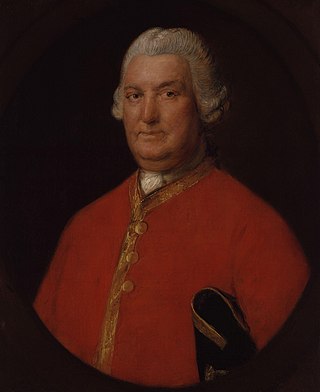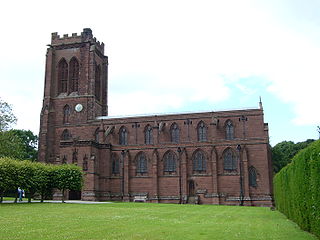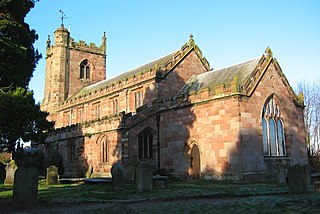
Stalybridge is a town in Tameside, Greater Manchester, England, with a population of 23,731 at the 2011 Census. Historically divided between Cheshire and Lancashire, it is 8 miles (12.9 km) east of Manchester city centre and 6 miles (9.7 km) north-west of Glossop.

Nantwich is a market town and civil parish in the unitary authority of Cheshire East in Cheshire, England. It has among the highest concentrations of listed buildings in England, with notably good examples of Tudor and Georgian architecture. It had a population of 14,045 in 2021.

John Rylands was an English entrepreneur and philanthropist. He was the owner of the largest textile manufacturing concern in the United Kingdom, and Manchester's first multi-millionaire.

Hyde is a town in Tameside, Greater Manchester, England, which had a population of 34,003 in 2011.

Mossley (/ˈmɒzli/) is a town and civil parish in Tameside, Greater Manchester, England. It is located in the upper Tame Valley and the foothills of the Pennines, 3 miles (4.8 km) south-east of Oldham and 8.9 miles (14.3 km) east of Manchester.

Miles Platting is an inner city part of Manchester, England, 1.4 miles (2.3 km) northeast of Manchester city centre along the Rochdale Canal and A62 road, bounded by Monsall to the north, Collyhurst to the west, Newton Heath to the east, and Bradford, Holt Town and Ancoats to the south.

Major-General Stringer Lawrence was an English soldier, the first Commander-in-Chief of Fort William.

Bredbury is a town in the Metropolitan Borough of Stockport, Greater Manchester, England, 8 miles (12.9 km) south-east of Manchester, 2 miles (3.2 km) east of Stockport and 3 miles (4.8 km) south-west of Hyde. At the 2011 census, it had a population of 16,721.

Woodford is a suburban village in the Metropolitan Borough of Stockport, Greater Manchester, England, 5.2 miles (8.4 km) south of Stockport, 5.7 miles (9.2 km) north-west of Macclesfield and 10.7 miles (17.2 km) south-east of Manchester. Woodford is the most southerly point of Greater Manchester and consists of a ribbon of properties and a housing development along the A5102 road, around which is open countryside.

St Mary's Church is in the village of Eccleston, Cheshire, England, on the estate of the Duke of Westminster south of Chester. The church is recorded in the National Heritage List for England as a designated Grade I listed building. It is an active Anglican parish church in the diocese of Chester, the archdeaconry of Chester and the deanery of Chester. Its benefice is combined with that of St Mary, Pulford. The Dukes of Westminster are buried in the adjacent Old Churchyard.

The de Trafford Baronetcy, of Trafford Park in the County Palatine of Lancaster is a title in the Baronetage of the United Kingdom.

St Margaret's Church overlooks the village green of Wrenbury, Cheshire, England. The church is recorded in the National Heritage List for England as a designated Grade II* listed building. It is an active Anglican parish church in the diocese of Chester, the archdeaconry of Macclesfield and the deanery of Nantwich. Its benefice is combined with those of St Michael's, Baddiley and St Mary's and St Michael's, Burleydam.

Gorse Hall was the name given to two large houses in Stalybridge, Greater Manchester, England, on a hill bordering Dukinfield, with 35 acres of woodland, and views of the Cheshire Plain and the Pennine Hills. Gorse Hall is a location in Anthony Trollope's Marion Fay (1882).

Frederick Platt-Higgins was a British businessman and Conservative MP for Salford North.

Taylor, Lang & Co. was a textile machinery manufacturer based in Stalybridge, Greater Manchester, England.

William Pole (1515–1587), Esquire, was a lawyer and speculator in church lands following the Dissolution of the Monasteries who served as MP for Lyme Regis in 1545, Bridport in 1553 and for West Looe in 1559. He acquired lands in East Devon and was the founder of the influential and wealthy Pole family of Shute, Devon. He was the father of the famous Sir William Pole (1561-1635), the antiquary, historian of Devon.

The Gaskell Memorial Tower and King's Coffee House are in King Street, Knutsford, Cheshire, England. As originally built, it had the triple function of being council offices, a coffee house, and a memorial to the novelist Elizabeth Gaskell, a former resident of the town who is often known as Mrs Gaskell. The building was designed by Richard Harding Watt with assistance from W. Longworth, and was opened in 1907. Its design incorporates features of many styles of architecture, and has not been praised by all critics. Incorporated on the tower are two depictions of Mrs Gaskell, a stone bust and a bronze relief. The building is recorded in the National Heritage List for England as a designated Grade II* listed building. The building is owned by Knutsford Town Council but since the early 1970s it has been used as a restaurant.

Robert Incledon (1676–1758) of Pilton House, Pilton, near Barnstaple in North Devon, was a lawyer of New Inn, London, a Clerk of the Peace for Devon, Deputy Recorder of Barnstaple and was twice Mayor of Barnstaple, in 1712 and 1721. In 1713 as mayor he supervised the building of the Mercantile Exchange on Barnstaple Quay, as recorded on the building by a contemporary brass plaque and sculpture of his armorials. He built Pilton House in 1746.

William John Seward Webber was an English sculptor who created civic statuary, and busts of national heroes and local worthies, in marble. He sculpted the statue of Queen Victoria for the Jubilee Monument in Harrogate, North Riding of Yorkshire, England in 1887. An early success was his Warrior and Wounded Youth group of 1878, executed while he was still a student. His busts include portraits of the Duke of Clarence, John Charles Dollman, Henry Phillpotts, John Bowring, John Ruskin, Richard Jefferies, Alfred, Lord Tennyson, Charles Darwin, Walter Scott, Thomas Carlyle, Robert Burns and Thomas Holroyd.



















